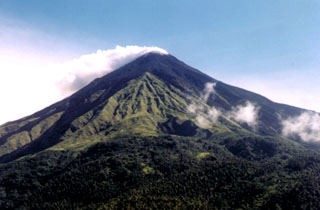Report on Karangetang (Indonesia) — 20 October-26 October 2021
Smithsonian Institution / US Geological Survey
Weekly Volcanic Activity Report, 20 October-26 October 2021
Managing Editor: Sally Sennert.
Please cite this report as:
Global Volcanism Program, 2021. Report on Karangetang (Indonesia) (Sennert, S, ed.). Weekly Volcanic Activity Report, 20 October-26 October 2021. Smithsonian Institution and US Geological Survey.
Karangetang
Indonesia
2.781°N, 125.407°E; summit elev. 1797 m
All times are local (unless otherwise noted)
The Darwin VAAC reported that on 25 October a pilot observed an ash plume from Karangetang rising to 3 km (10,000 ft) a.s.l. and drifting SW. Continuous ash emissions were also visible in satellite images, though emissions ceased within five hours. The Alert Level remained at 2 (on a scale of 1-4).
Geological Summary. Karangetang (Api Siau) volcano lies at the northern end of the island of Siau, about 125 km NNE of the NE-most point of Sulawesi. The stratovolcano contains five summit craters along a N-S line. It is one of Indonesia's most active volcanoes, with more than 40 eruptions recorded since 1675 and many additional small eruptions that were not documented (Neumann van Padang, 1951). Twentieth-century eruptions have included frequent explosive activity sometimes accompanied by pyroclastic flows and lahars. Lava dome growth has occurred in the summit craters; collapse of lava flow fronts have produced pyroclastic flows.

